Management of junior secondary schools teachers training activities under accessing human resources in the current period
In approaching capacity, professional capacity plays an important role. One of the current major trends in the approach to professional competence is standardization. The criteria of the professional standards are designed according to the model of expanded development, the level of increasing and higher than the standard of training, is the orientation to continuously strive for the career of junior high school teachers. Therefore, management of secondary school teachers’ training according to competency to build secondary teachers with adequate moral qualities, knowledge and professional skills is an important and urgent issue contributing to the development of teachers. sex in the future. From deeply evaluating the current status of management of training of secondary school teachers according to human resource access in the current period, the author has proposed 7 measures to manage the training of middle school teachers. The basis for access to the source of resources has the necessity and high feasibility
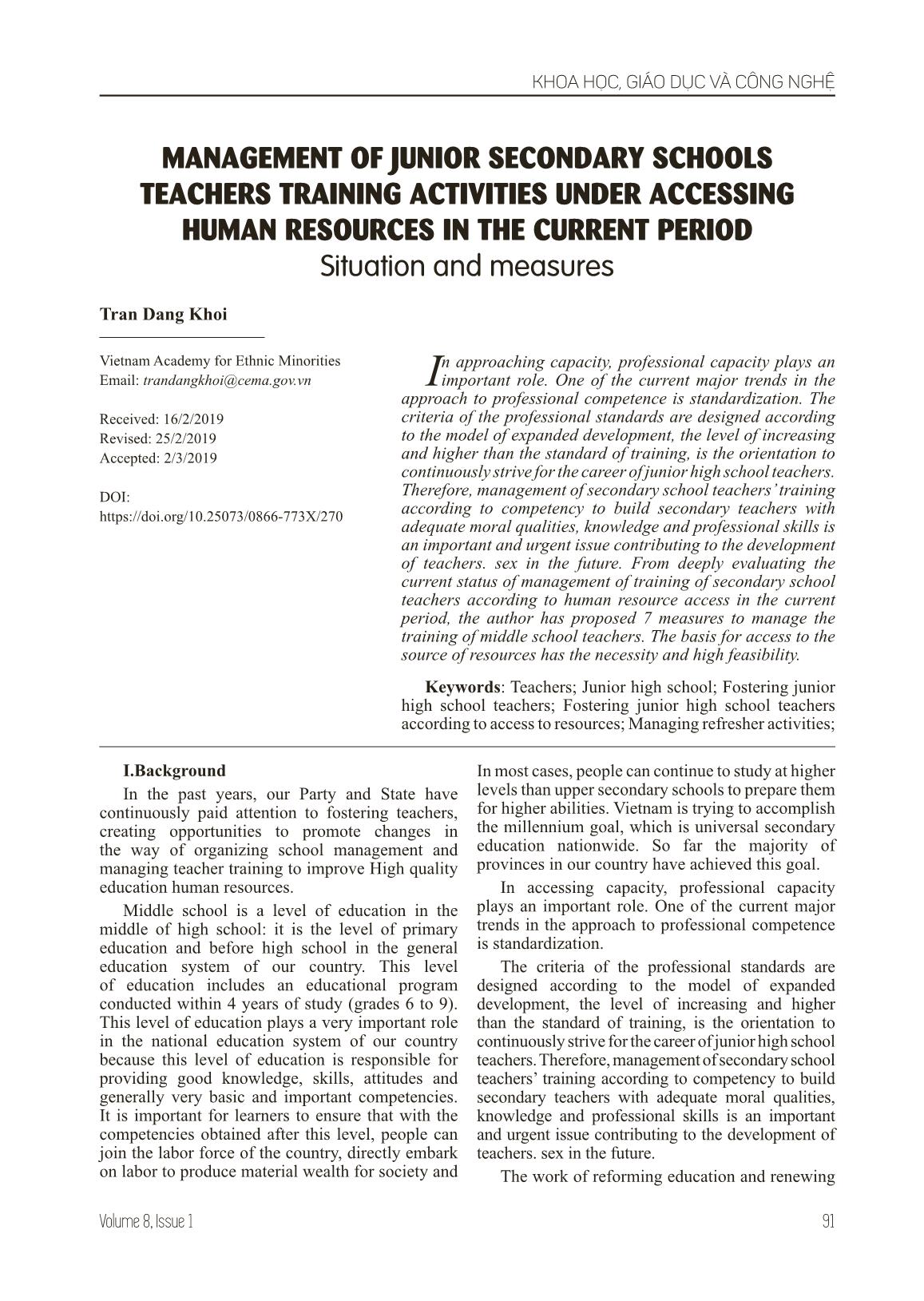
Trang 1
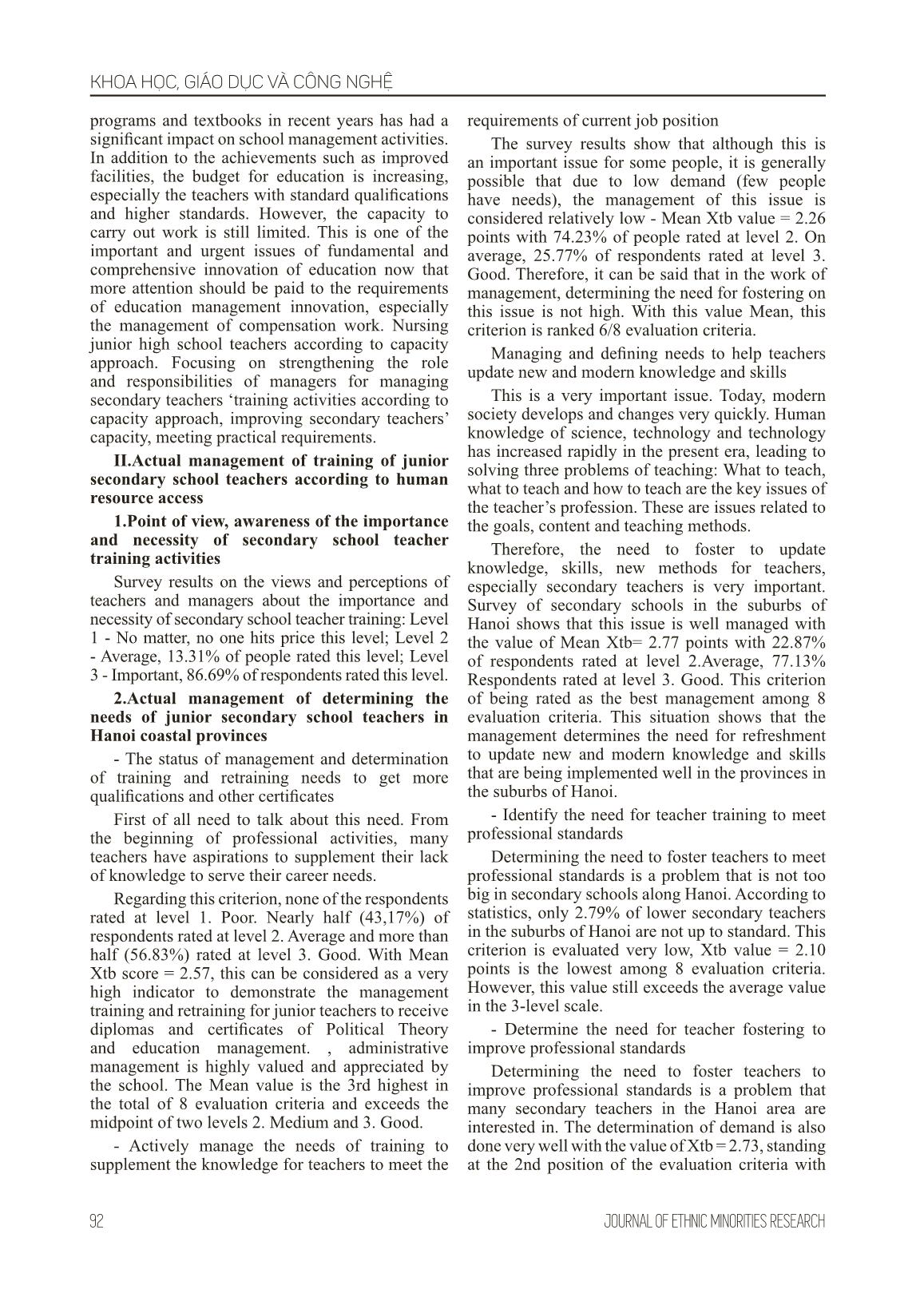
Trang 2
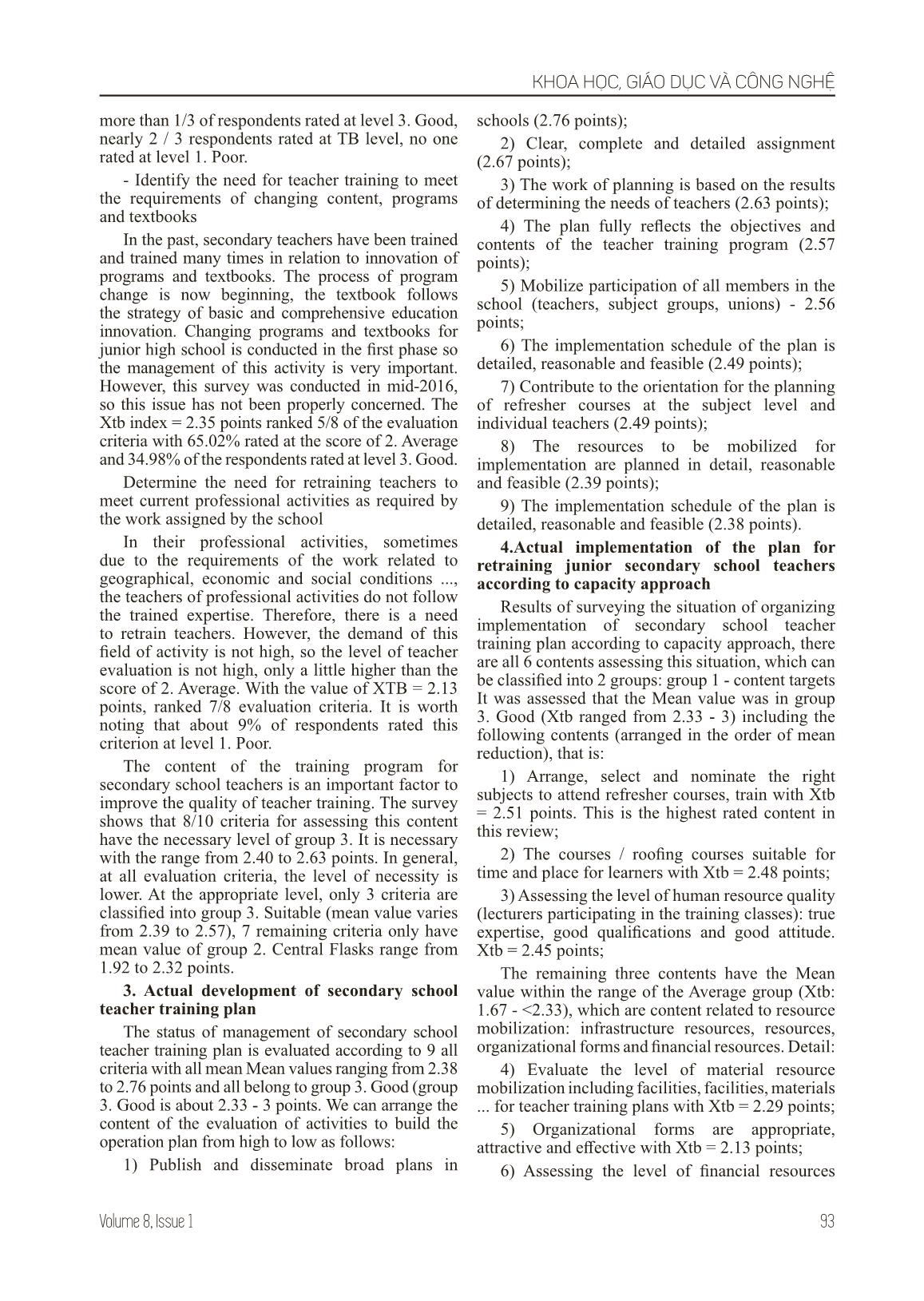
Trang 3
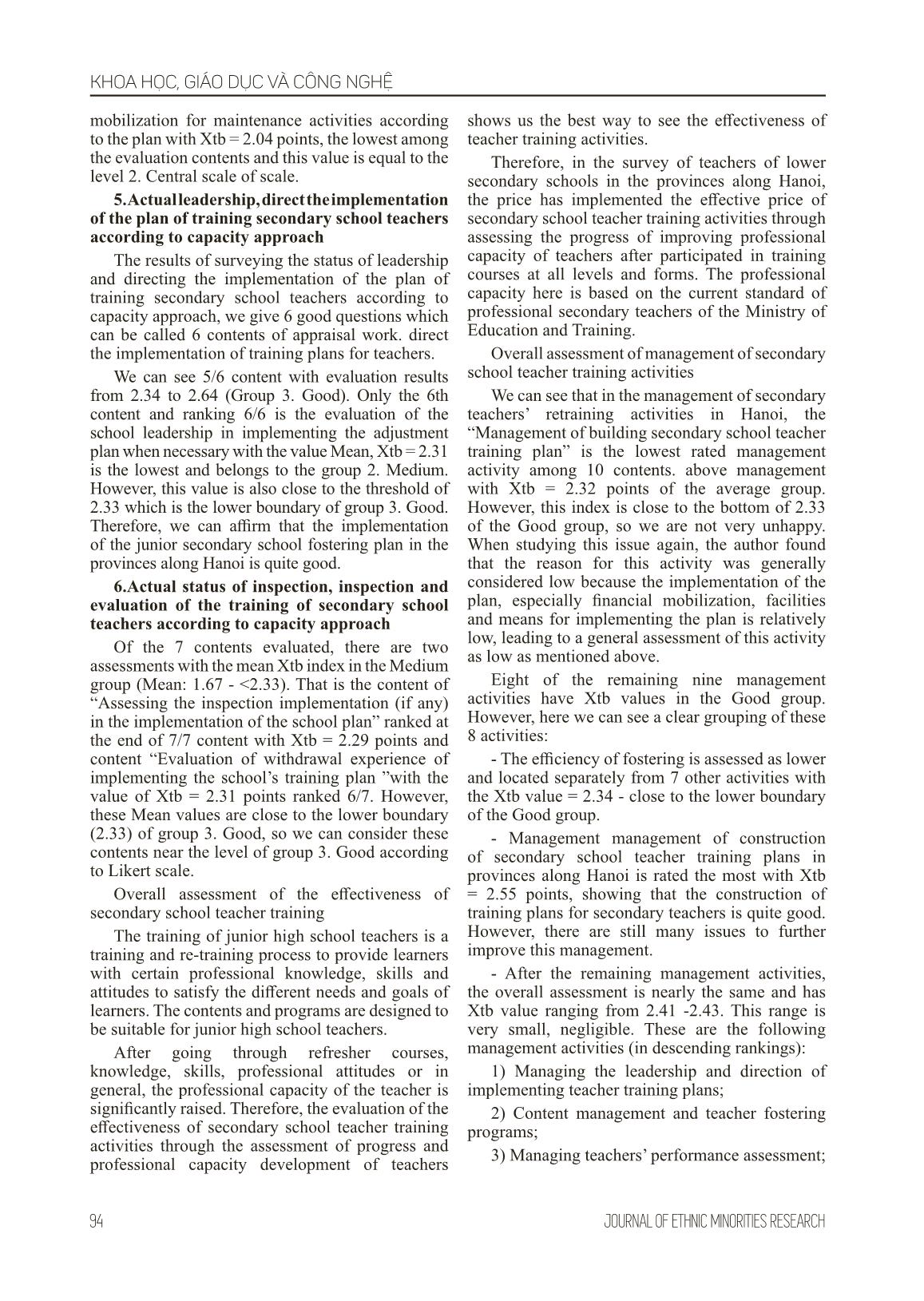
Trang 4
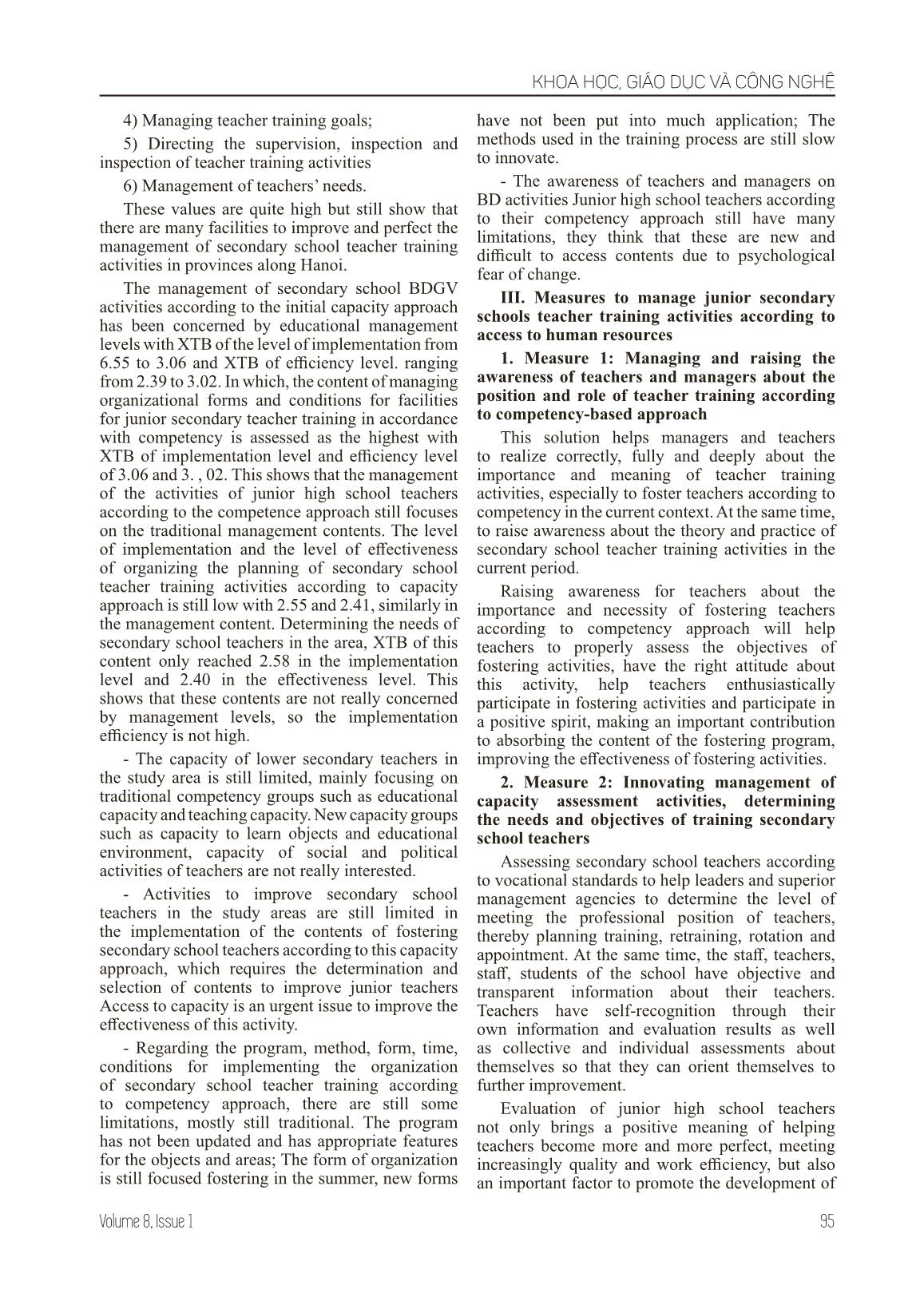
Trang 5
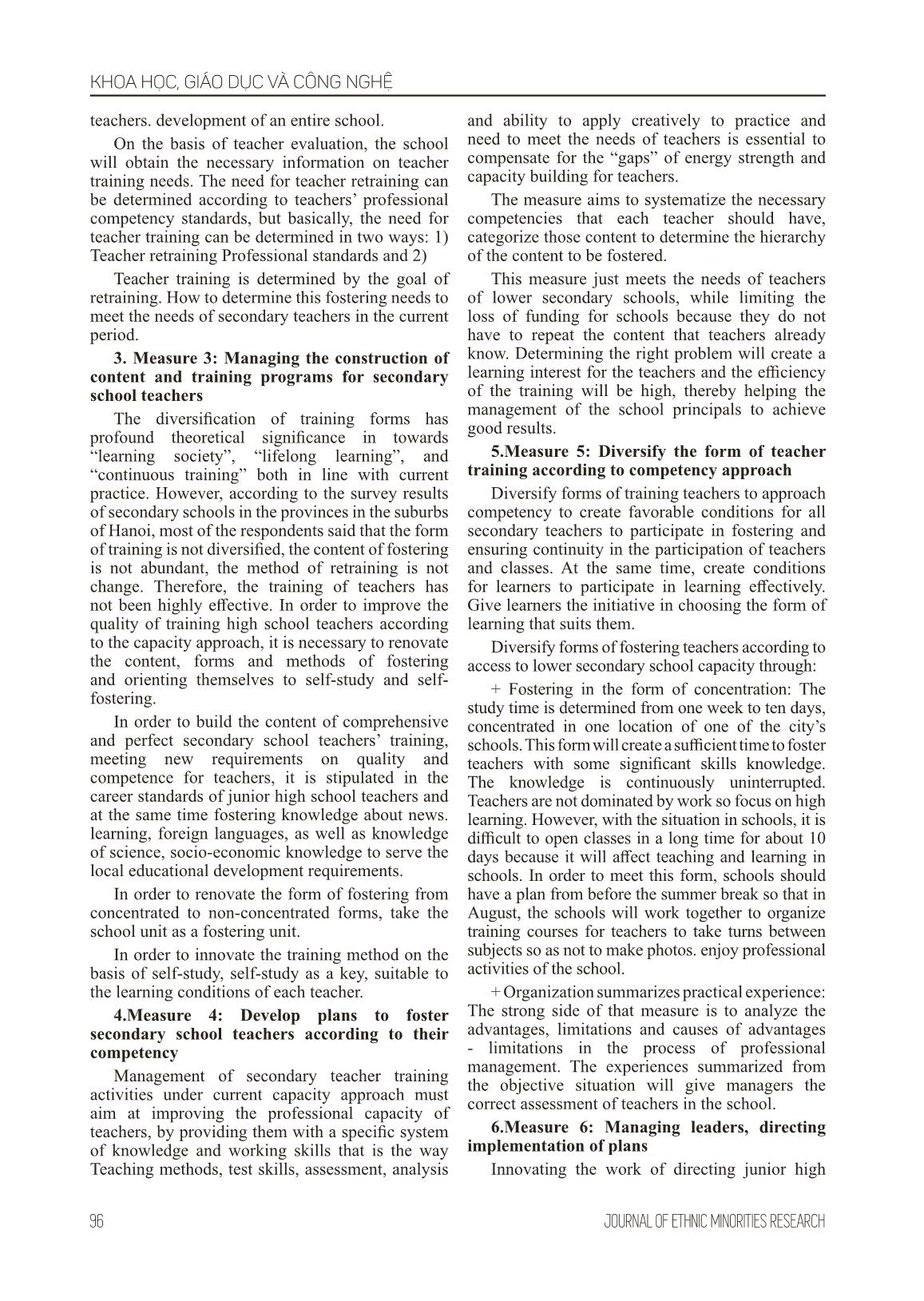
Trang 6
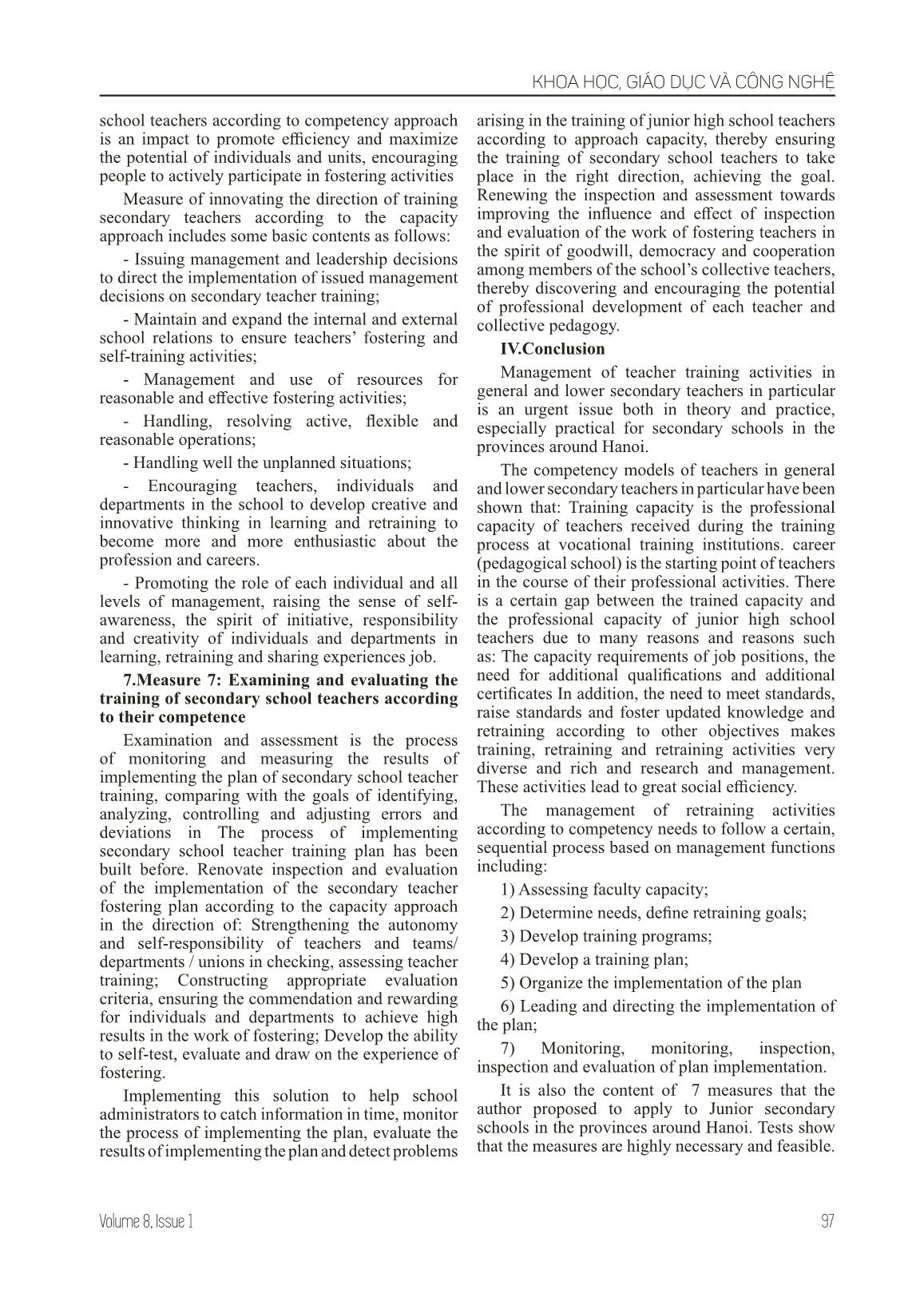
Trang 7
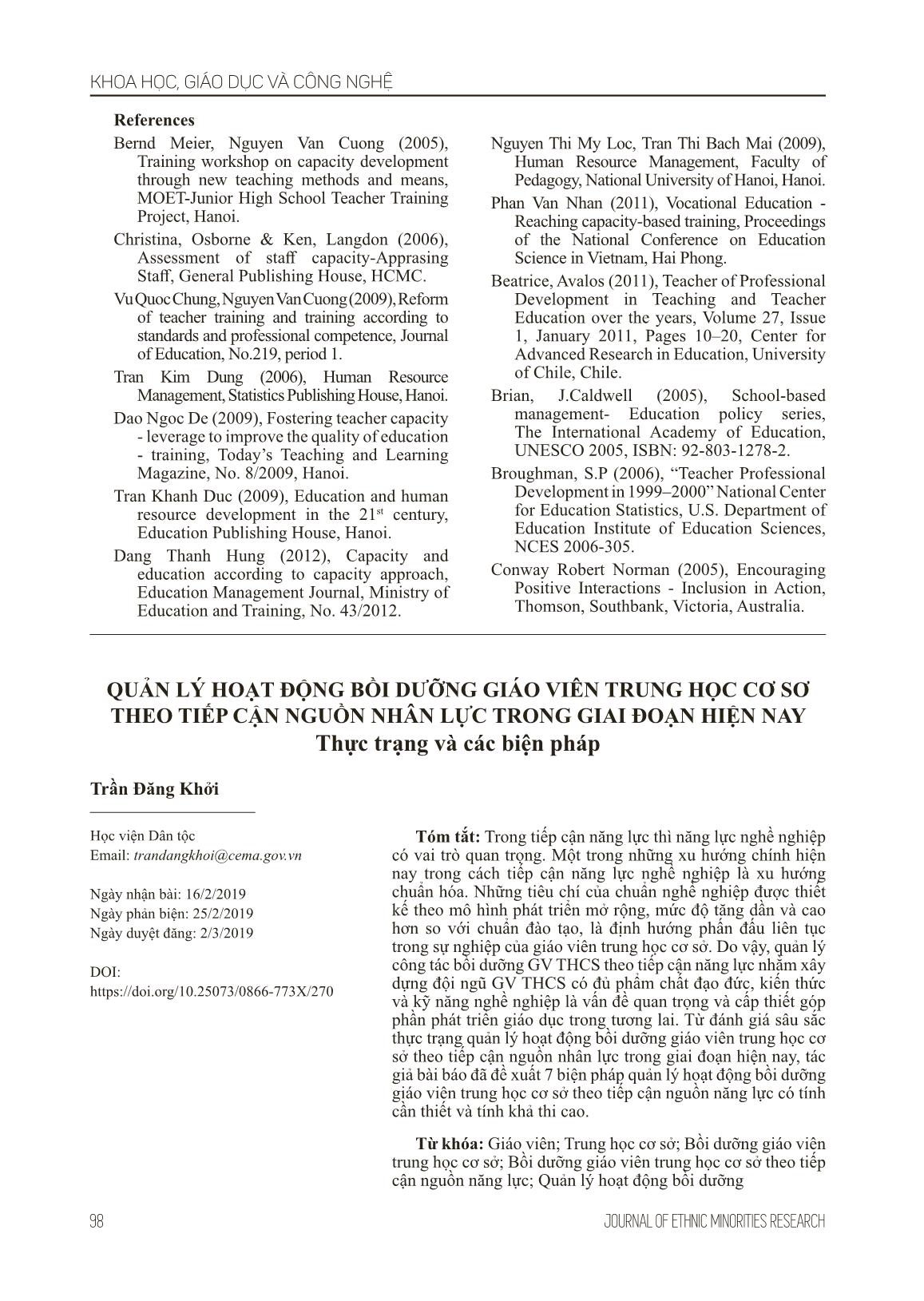
Trang 8
Tóm tắt nội dung tài liệu: Management of junior secondary schools teachers training activities under accessing human resources in the current period
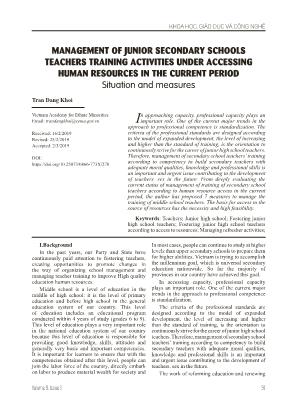
sment activities, determining the needs and objectives of training secondary school teachers Assessing secondary school teachers according to vocational standards to help leaders and superior management agencies to determine the level of meeting the professional position of teachers, thereby planning training, retraining, rotation and appointment. At the same time, the staff, teachers, staff, students of the school have objective and transparent information about their teachers. Teachers have self-recognition through their own information and evaluation results as well as collective and individual assessments about themselves so that they can orient themselves to further improvement. Evaluation of junior high school teachers not only brings a positive meaning of helping teachers become more and more perfect, meeting increasingly quality and work efficiency, but also an important factor to promote the development of KHOA HỌC, GIÁO DỤC VÀ CÔNG NGHỆ 96 JOURNAL OF ETHNIC MINORITIES RESEARCH teachers. development of an entire school. On the basis of teacher evaluation, the school will obtain the necessary information on teacher training needs. The need for teacher retraining can be determined according to teachers’ professional competency standards, but basically, the need for teacher training can be determined in two ways: 1) Teacher retraining Professional standards and 2) Teacher training is determined by the goal of retraining. How to determine this fostering needs to meet the needs of secondary teachers in the current period. 3. Measure 3: Managing the construction of content and training programs for secondary school teachers The diversification of training forms has profound theoretical significance in towards “learning society”, “lifelong learning”, and “continuous training” both in line with current practice. However, according to the survey results of secondary schools in the provinces in the suburbs of Hanoi, most of the respondents said that the form of training is not diversified, the content of fostering is not abundant, the method of retraining is not change. Therefore, the training of teachers has not been highly effective. In order to improve the quality of training high school teachers according to the capacity approach, it is necessary to renovate the content, forms and methods of fostering and orienting themselves to self-study and self- fostering. In order to build the content of comprehensive and perfect secondary school teachers’ training, meeting new requirements on quality and competence for teachers, it is stipulated in the career standards of junior high school teachers and at the same time fostering knowledge about news. learning, foreign languages, as well as knowledge of science, socio-economic knowledge to serve the local educational development requirements. In order to renovate the form of fostering from concentrated to non-concentrated forms, take the school unit as a fostering unit. In order to innovate the training method on the basis of self-study, self-study as a key, suitable to the learning conditions of each teacher. 4.Measure 4: Develop plans to foster secondary school teachers according to their competency Management of secondary teacher training activities under current capacity approach must aim at improving the professional capacity of teachers, by providing them with a specific system of knowledge and working skills that is the way Teaching methods, test skills, assessment, analysis and ability to apply creatively to practice and need to meet the needs of teachers is essential to compensate for the “gaps” of energy strength and capacity building for teachers. The measure aims to systematize the necessary competencies that each teacher should have, categorize those content to determine the hierarchy of the content to be fostered. This measure just meets the needs of teachers of lower secondary schools, while limiting the loss of funding for schools because they do not have to repeat the content that teachers already know. Determining the right problem will create a learning interest for the teachers and the efficiency of the training will be high, thereby helping the management of the school principals to achieve good results. 5.Measure 5: Diversify the form of teacher training according to competency approach Diversify forms of training teachers to approach competency to create favorable conditions for all secondary teachers to participate in fostering and ensuring continuity in the participation of teachers and classes. At the same time, create conditions for learners to participate in learning effectively. Give learners the initiative in choosing the form of learning that suits them. Diversify forms of fostering teachers according to access to lower secondary school capacity through: + Fostering in the form of concentration: The study time is determined from one week to ten days, concentrated in one location of one of the city’s schools. This form will create a sufficient time to foster teachers with some significant skills knowledge. The knowledge is continuously uninterrupted. Teachers are not dominated by work so focus on high learning. However, with the situation in schools, it is difficult to open classes in a long time for about 10 days because it will affect teaching and learning in schools. In order to meet this form, schools should have a plan from before the summer break so that in August, the schools will work together to organize training courses for teachers to take turns between subjects so as not to make photos. enjoy professional activities of the school. + Organization summarizes practical experience: The strong side of that measure is to analyze the advantages, limitations and causes of advantages - limitations in the process of professional management. The experiences summarized from the objective situation will give managers the correct assessment of teachers in the school. 6.Measure 6: Managing leaders, directing implementation of plans Innovating the work of directing junior high KHOA HỌC, GIÁO DỤC VÀ CÔNG NGHỆ 97Volume 8, Issue 1 school teachers according to competency approach is an impact to promote efficiency and maximize the potential of individuals and units, encouraging people to actively participate in fostering activities Measure of innovating the direction of training secondary teachers according to the capacity approach includes some basic contents as follows: - Issuing management and leadership decisions to direct the implementation of issued management decisions on secondary teacher training; - Maintain and expand the internal and external school relations to ensure teachers’ fostering and self-training activities; - Management and use of resources for reasonable and effective fostering activities; - Handling, resolving active, flexible and reasonable operations; - Handling well the unplanned situations; - Encouraging teachers, individuals and departments in the school to develop creative and innovative thinking in learning and retraining to become more and more enthusiastic about the profession and careers. - Promoting the role of each individual and all levels of management, raising the sense of self- awareness, the spirit of initiative, responsibility and creativity of individuals and departments in learning, retraining and sharing experiences job. 7.Measure 7: Examining and evaluating the training of secondary school teachers according to their competence Examination and assessment is the process of monitoring and measuring the results of implementing the plan of secondary school teacher training, comparing with the goals of identifying, analyzing, controlling and adjusting errors and deviations in The process of implementing secondary school teacher training plan has been built before. Renovate inspection and evaluation of the implementation of the secondary teacher fostering plan according to the capacity approach in the direction of: Strengthening the autonomy and self-responsibility of teachers and teams/ departments / unions in checking, assessing teacher training; Constructing appropriate evaluation criteria, ensuring the commendation and rewarding for individuals and departments to achieve high results in the work of fostering; Develop the ability to self-test, evaluate and draw on the experience of fostering. Implementing this solution to help school administrators to catch information in time, monitor the process of implementing the plan, evaluate the results of implementing the plan and detect problems arising in the training of junior high school teachers according to approach capacity, thereby ensuring the training of secondary school teachers to take place in the right direction, achieving the goal. Renewing the inspection and assessment towards improving the influence and effect of inspection and evaluation of the work of fostering teachers in the spirit of goodwill, democracy and cooperation among members of the school’s collective teachers, thereby discovering and encouraging the potential of professional development of each teacher and collective pedagogy. IV.Conclusion Management of teacher training activities in general and lower secondary teachers in particular is an urgent issue both in theory and practice, especially practical for secondary schools in the provinces around Hanoi. The competency models of teachers in general and lower secondary teachers in particular have been shown that: Training capacity is the professional capacity of teachers received during the training process at vocational training institutions. career (pedagogical school) is the starting point of teachers in the course of their professional activities. There is a certain gap between the trained capacity and the professional capacity of junior high school teachers due to many reasons and reasons such as: The capacity requirements of job positions, the need for additional qualifications and additional certificates In addition, the need to meet standards, raise standards and foster updated knowledge and retraining according to other objectives makes training, retraining and retraining activities very diverse and rich and research and management. These activities lead to great social efficiency. The management of retraining activities according to competency needs to follow a certain, sequential process based on management functions including: 1) Assessing faculty capacity; 2) Determine needs, define retraining goals; 3) Develop training programs; 4) Develop a training plan; 5) Organize the implementation of the plan 6) Leading and directing the implementation of the plan; 7) Monitoring, monitoring, inspection, inspection and evaluation of plan implementation. It is also the content of 7 measures that the author proposed to apply to Junior secondary schools in the provinces around Hanoi. Tests show that the measures are highly necessary and feasible. KHOA HỌC, GIÁO DỤC VÀ CÔNG NGHỆ 98 JOURNAL OF ETHNIC MINORITIES RESEARCH QUẢN LÝ HOẠT ĐỘNG BỒI DƯỠNG GIÁO VIÊN TRUNG HỌC CƠ SƠ THEO TIẾP CẬN NGUỒN NHÂN LỰC TRONG GIAI ĐOẠN HIỆN NAY Thực trạng và các biện pháp Trần Đăng Khởi Học viện Dân tộc Email: trandangkhoi@cema.gov.vn Ngày nhận bài: 16/2/2019 Ngày phản biện: 25/2/2019 Ngày duyệt đăng: 2/3/2019 DOI: https://doi.org/10.25073/0866-773X/270 Tóm tắt: Trong tiếp cận năng lực thì năng lực nghề nghiệp có vai trò quan trọng. Một trong những xu hướng chính hiện nay trong cách tiếp cận năng lực nghề nghiệp là xu hướng chuẩn hóa. Những tiêu chí của chuẩn nghề nghiệp được thiết kế theo mô hình phát triển mở rộng, mức độ tăng dần và cao hơn so với chuẩn đào tạo, là định hướng phấn đấu liên tục trong sự nghiệp của giáo viên trung học cơ sở. Do vậy, quản lý công tác bồi dưỡng GV THCS theo tiếp cận năng lực nhằm xây dựng đội ngũ GV THCS có đủ phẩm chất đạo đức, kiến thức và kỹ năng nghề nghiệp là vấn đề quan trọng và cấp thiết góp phần phát triển giáo dục trong tương lai. Từ đánh giá sâu sắc thực trạng quản lý hoạt động bồi dưỡng giáo viên trung học cơ sở theo tiếp cận nguồn nhân lực trong giai đoạn hiện nay, tác giả bài báo đã đề xuất 7 biện pháp quản lý hoạt động bồi dưỡng giáo viên trung học cơ sở theo tiếp cận nguồn năng lực có tính cần thiết và tính khả thi cao. Từ khóa: Giáo viên; Trung học cơ sở; Bồi dưỡng giáo viên trung học cơ sở; Bồi dưỡng giáo viên trung học cơ sở theo tiếp cận nguồn năng lực; Quản lý hoạt động bồi dưỡng References Bernd Meier, Nguyen Van Cuong (2005), Training workshop on capacity development through new teaching methods and means, MOET-Junior High School Teacher Training Project, Hanoi. Christina, Osborne & Ken, Langdon (2006), Assessment of staff capacity-Apprasing Staff, General Publishing House, HCMC. Vu Quoc Chung, Nguyen Van Cuong (2009), Reform of teacher training and training according to standards and professional competence, Journal of Education, No.219, period 1. Tran Kim Dung (2006), Human Resource Management, Statistics Publishing House, Hanoi. Dao Ngoc De (2009), Fostering teacher capacity - leverage to improve the quality of education - training, Today’s Teaching and Learning Magazine, No. 8/2009, Hanoi. Tran Khanh Duc (2009), Education and human resource development in the 21st century, Education Publishing House, Hanoi. Dang Thanh Hung (2012), Capacity and education according to capacity approach, Education Management Journal, Ministry of Education and Training, No. 43/2012. Nguyen Thi My Loc, Tran Thi Bach Mai (2009), Human Resource Management, Faculty of Pedagogy, National University of Hanoi, Hanoi. Phan Van Nhan (2011), Vocational Education - Reaching capacity-based training, Proceedings of the National Conference on Education Science in Vietnam, Hai Phong. Beatrice, Avalos (2011), Teacher of Professional Development in Teaching and Teacher Education over the years, Volume 27, Issue 1, January 2011, Pages 10–20, Center for Advanced Research in Education, University of Chile, Chile. Brian, J.Caldwell (2005), School-based management- Education policy series, The International Academy of Education, UNESCO 2005, ISBN: 92-803-1278-2. Broughman, S.P (2006), “Teacher Professional Development in 1999–2000” National Center for Education Statistics, U.S. Department of Education Institute of Education Sciences, NCES 2006-305. Conway Robert Norman (2005), Encouraging Positive Interactions - Inclusion in Action, Thomson, Southbank, Victoria, Australia.
File đính kèm:
 management_of_junior_secondary_schools_teachers_training_act.pdf
management_of_junior_secondary_schools_teachers_training_act.pdf

